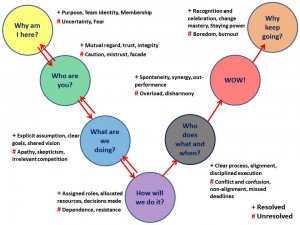Decision Model
A model can be anything that defines a process (iterative, linear, or chaotic) in which you move from a particular starting point to a desired destination. Some models are rather straight forward. Take, for instance, planning a business trip from Rochester, MN (my home town) to Los Angeles, CA to attend a conference. I would simply register for the conference, book the hotel, book the flight, pack bags, etc. The timeline is linear, and the process requires little to no effort to design and accomplish. Other models aren’t so easy or simple.
Find the Right Questions
“If I had an hour to solve a problem and my life depended on the solution, I would spend the first fifty-five minutes determining the proper question to ask, for once I know the proper question, I could solve the problem in less than five minutes.”–Albert Einstein
The Drexler-Sibbet, team-performance, decision model (shown in the diagram above) lays out a seven step process that a team will go through on nearly every project. Each step centers around a defining question. These questions will help the team stay on task and not get ahead of itself.
Execute the Solution
The first four steps in the Drexler-Sibbet process are highly iterative, require significant discussion by all members of the team, and will help to provide a cohesive group. Don’t overlook the value of this part of the process–it is truly the foundation.
The last three steps are all about execution. The real value of the first part of the process shows up in the execution. How does your organization say yes? Better yet, how and when does your organization say no? How do stray projects “show up” in the execution phase and alter those efforts in the planning phase?
Encourage your team not to get ahead of itself–to take it step by step, in other words. And encourage them not to do too much back-tracking in order to justify answers to questions in the execution phases.
As a leader, your main job is to be the question-asker, not the answer-provider. Trust your team to execute.
“The best executive is one who has the sense enough to pick good men [or women] to do what he wants done, and self-restraint enough to keep from meddling with them while they do it.”–President Theodore Roosevelt




